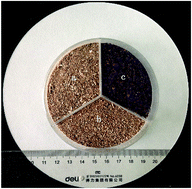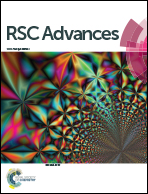Utilization of modified Dioscorea opposita Thunb. as a novel biosorbent for the adsorption of indigo carmine in aqueous solutions†
Abstract
It is important to identify efficient adsorbents for the removal of dyestuffs from aqueous solutions as this kind of pollution becomes more extensive. In this study, Dioscorea opposita Thunb. (DOT) was modified with polyethylene imine (DOT@PEI) as a novel biosorbent to remove the typical anionic dye indigo carmine (IC) from wastewater. The modified DOT@PEI biosorbent was characterized using BET (Brunauer–Emmett–Teller), SEM (scanning electron microscopy), EDS (energy dispersive spectroscopy), and FTIR (Fourier transform infrared spectroscopy) methods, and the results demonstrated that DOT@PEI is an excellent biosorbent. Batch adsorption studies showed that optimum adsorption parameters were pH 2.0, 1.0 g L−1 dosage, and temperature of 20 °C. The isothermal adsorption data showed good fitting to the Langmuir model, with a maximum adsorption capability of 344.83 mg g−1 for IC. Kinetic experiments showed that the experimental data fitted well to a pseudo-second-order kinetic model and the thermodynamic parameters indicated that adsorption is a spontaneous exothermic process. Adsorption–desorption experiments illustrated the good regeneration capability of DOT@PEI. These results demonstrate that DOT@PEI can be used as an effective biosorbent in water for the removal of anionic dyes such as required for environmental applications.



 Please wait while we load your content...
Please wait while we load your content...